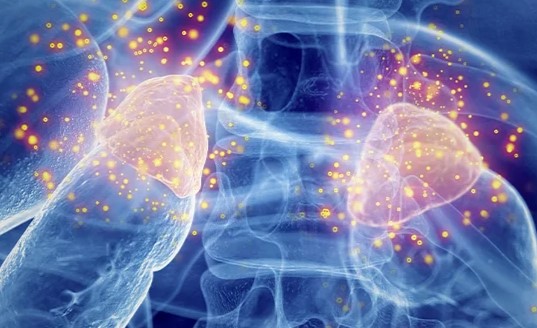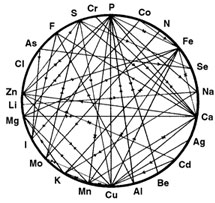Regaining Balance:
How to Overcome Maladapted
Stress Responses
Stress is an unavoidable part
of life, and it can come from both external and internal sources.
While it is normal to experience stress, it is important to recognize
when it becomes maladapted. Maladapted stress responses (or adrenal
burnout) are the body's response to stress that is out of balance and
can cause physical, mental, and emotional distress.
By
recognizing the signs and symptoms of maladapted stress responses,
you can take steps to regain balance and manage stress more
effectively. Understanding the signs and symptoms of maladapted
stress responses, you can learn how to recognize and manage stress
triggers and unhelpful thinking patterns, practice mindfulness
techniques, develop self- compassion, and incorporate self-care
strategies.
What do we
mean by balance in a living system? It means that like night follows
day, rest must follow activity. Extremes that go on for too long
with no recovery will exhaust the body’s ability to right itself.
What we call stress is a danger response. That vigilance and
readiness to respond to danger is very demanding of all of our
resources.
The danger
response changes us and shifts our energies at every level from
growth and repair, to defense. Energies are diverted to the muscles.
Blood sugar and blood pressure rise. The mind is scanning for
danger and becomes more black and white in its thinking. We are on a
hair trigger to fight or run. Anger and fear, our survival emotions
are activated. Everything else is set aside until the danger is
past.
Completing The Stress Cycle

What we call stress is in many cases a danger response. Having that stress response with no way to take action and respond is the most damaging stress we can have. This is a survival response. Our whole system is being mobilized to take action to fight or run.
Instead, we
are just sitting there. Sitting in traffic, sitting in a meeting,
sitting on hold on the phone. Sitting there, taking it and that
means that the stress response stays on. Becoming chronic stress.
Completing
the stress cycle requires a response to the threat. To run or to
fight. To win or to get away. That signals your body and mind that
the threat has passed, and you can relax and celebrate. But that
completion often never comes in our modern world. The stress remains
unresolved.
The threat may be constant because of dysfunctional relationships, a bad job or a dangerous neighborhood. We can also create our own stress by worrying and constantly criticizing ourselves. We may be placing unrealistic demands on what we and our life should be and always raising the bar on those expectations. This is how we will remain stressed and feel threatened no matter how good and safe our life actually is.
Energy and Balance
Balance is composed of many factors. The available energy can make a huge difference in what can be tolerated and what cannot. How many tasks are you juggling? How many drains are there on your system? Improving even one major issue like inadequate sleep or poor diet can take a significant load off of the demands being made. It can restore balance for some time.
But if
deeper chronic issues remain, such as food allergies, metal
toxicities, Copper Toxicity and a maladapted stress response, they
will continue to cause chronic stress. They will continue to disturb
and drain your energy. These conditions tend to get worse with time
if they are not corrected. In months or years, the great initial
health improvement from better sleep and diet begins to fail. You
start to decline again even though you are still doing everything
that worked so well at first.
You find that you still have to maintain all those earlier changes and improvements or you will get even worse. What is happening? There are missing pieces that have not been identified and effectively addressed. It does not mean you are not on the right track. It does mean that there is more to do. Building on the good foundation of your previous improvements, you can gain great results.
Subscribe to THE HEALING PROCESS newsletter on Substack
Adrenal Burnout
and Chronic Illness

Balance becomes more and more imbalanced when the stresses and demands on us are too intense and too prolonged for the body to adapt. The body can adapt for years and years using the many kinds of back up systems we have to cope with and survive emergencies and threats. But these are not meant to be our standard operating systems. They are meant to be used short term and then we recover.
A prolonged
danger response forces the body to draw on its deepest reserves and
to divert energy and other resources away from very essential body
functions. The recovery and completion of the stress cycle never
really happens. Digestion, detoxification, healing, tissue building,
and sleep are all being disrupted and not getting the time and
resources to build and restore the body. Keeping up with a constant
sympathetic danger response will result in more and more chronic
imbalances as the body does all it can to adapt to keep you alive.
Chronic
stress begins to shift the balance of the body more and more with
time. As the body creates more defenses and adaptations that work
well in the short term, they take a toll in the long term. The
consumption and diversion of energy and resources from the life
giving, regenerating processes of the parasympathetic metabolism to
the danger response and defensive adaptations weakens the body more
and more. It reduces the energy available for life.
The body
continues to adapt and to find the least damaging way to cope with
the current conditions. Each adaptation consumes and locks up more
resources in order to maintain the defensive activity. Then the body
is forced to fall back and resort to more and more damaging
compromises with the remaining resources available.
The rolling
black-out has begun, and hard choices are being made every single day.
The symptoms are really the effect of those hard choices. Something
has to give in order to keep going. Your illness is, in fact, the
way you are surviving this breakdown in energy and chronic stress.
It is the best available deal for your body under the current
conditions.
As the balance becomes more strained and demanding, the short-term coping strategies begin to turn on you. The higher calcium in the tissues which often act as a stress shield become a cause of slow oxidation. As energy production becomes more impaired, it helps the body to slow down and live with the less available energy. But as this defensive behavior persists, it results in even less available energy for the body and mind. More and more functions end up on the back burner and health declines.
Balancing Therapies

Balance includes extremes: day and night, summer and winter, hot and cold, sun and shade. This reality is what is meant by the terms Yang and Yin. These are the opposites that are present in every single part of the universe. Positive and negative. Heaven and earth. Fire and water. They all oppose yet balance each other. That is the principle of balancing therapies such as Chinese Medicine and Nutritional Balancing.
Nutritional Balancing and Chinese Medicine are both systems that recognize patterns of imbalance in the body and mind and is designed to correct them. The fact that nutrients have both activating and calming effects on the metabolism is the basis of Nutritional Balancing. The same is true for Chinese Herbal Therapy. Each of these systems allows us to determine where the body has become stuck in extremes, and where it has lost the ability to right itself and regain homeostasis.
Using balancing therapies such as Nutritional Balancing and Chinese Herbal Therapy to restore the balance of the autonomic nervous system and get out of sympathetic dominance can be a very effective way to regain balance and manage stress more effectively. This is essential to be in a healing state. Healing is always impaired by chronic stress.
Balancing therapies such as Nutritional Balancing and Chinese herbal therapy are strongly supportive of the effectiveness of all the strategies to regain autonomic nervous system balance. Regaining a balanced stress response and increasing vagal tone is essential to healing all illnesses, especially chronic fatigue and adrenal fatigue.
The targeted therapies such as Nutritional Balancing and Chinese Herbal Therapy will help the body and mind to regain balance and energy. But the best results will come from a strong foundation of stress management and self-care. Learning to recognize your own pattern of habits and triggers, can give you the power to reset and control those stress responses.
Foods and herbs have their own natures and effects. Some are warming and activating (yang), others are cooling and calming (yin). The denser foods that are higher in protein and fats are nourishing and strengthening and give long lasting energy. They are also essential for making the body structures and tissues. The lighter, more watery foods have many good nutrients and fiber, and they balance the heavy nature of the proteins and fats. Nearly all of the body is made of protein, and we can only get protein by eating foods that contain it. It cannot be made from fats or carbohydrates.
Carbohydrates like sugars and starches are mainly burned for energy, or they are converted to fats and stored for later use. Carbs have little or no structural functions in the body unless they are stored as fat. We can use all of the macro nutrients: protein, fat and carbs, for energy. We convert some of the protein we eat to glucose each time for example. This is part of why we don’t have to eat large amounts of carbs to live.
Some of us are better at burning carbohydrates than others. Chronic stress and adrenal burnout can cause various metabolic disturbances that we call glucose intolerance. Some people become so sugar intolerant that they need a low carb diet in order to calm the stress response and regain balance.
The Signs and Symptoms of
Maladapted Stress Responses
By understanding the signs and symptoms of maladapted stress responses (or adrenal burnout), you can learn how to regain balance in your body and mind and manage stress more effectively.
Acute stress vs. chronic stress:
- Acute stress comes from demands and pressures of the recent past and anticipated demands and pressures of the near future. Acute stress is thrilling and exciting in small doses, but too much is exhausting.
- Chronic stress is constant and persists over an extended period. It can be debilitating and overwhelming. Chronic stress can affect both our physical and psychological well-being by causing a variety of problems including anxiety, insomnia, muscle pain, high blood pressure and a weakened immune system.
Chronic stress is the primary process that dis-regulates the stress response. It is important to understand that chronic stress can be caused by both external and internal sources. External sources of stress include work, relationships, financial strains, school, and other environmental factors. Internal sources of stress include thoughts, beliefs, and emotions.
What are Maladapted
Stress Responses?
Maladapted stress responses are the body's response to stress that is out of balance. When the body is in a state of maladapted stress (or adrenal burnout), it is unable to properly manage and respond to stressors. This can lead to a wide range of physical, mental, and emotional symptoms that can significantly impact an individual's functioning.
The body's
response to stress is regulated by the autonomic nervous system
(ANS), which is responsible for regulating the body's involuntary
functions. This includes heart rate, breathing, digestion, and other
bodily functions. During times of stress, the ANS shifts into a
"fight or flight" response, which is characterized by
increased heart rate and respiration, higher blood pressure, and a
surge in hormones like cortisol and adrenaline. When the ANS is in a
state of maladapted stress, it is unable to shift out of this "fight
or flight" response and back into a state of balance.
Maladapted
stress responses can manifest in a variety of physical, mental, and
emotional symptoms. These symptoms can vary from person to person,
but some common signs and symptoms of maladapted stress responses
include:
- Physical symptoms such as headaches, muscle tension, digestive issues, and difficulty sleeping
- Cognitive symptoms such as difficulty concentrating, forgetfulness, and difficulty making decisions Emotional symptoms such as irritability, anxiety, and depression.
- Behavioral symptoms such as isolation, avoidance, and changes in eating or drinking habits
It is important to recognize the signs and symptoms of maladapted stress responses to take steps to regain balance and manage stress more effectively.
The Autonomic Nervous System (ANS)
The autonomic nervous system is our automatic nervous system. It is made of two opposing yet balancing parts. The para-sympathetic (yin) nervous system (PNS) is often called the housekeeping system or safe and social. When this system is dominant, then the body is able to support all of the systems that keep you alive, happy and healthy. The vagus nerve is the primary nerve of the PNS. Doing things that increase the activity of the parasympathetic system is called increasing your vagal tone.
When your
vagal tone is strong, your digestion is active and able to supply all
of the nutrients needed for energy and good tissues and metabolism.
Tissue repair is being done as needed along with new tissue growth.
Detoxification is effective throughout the body and in the liver and
kidneys. Sleep is restful and restorative. The mind is peaceful and
creative. The joy of life is felt, and fulfillment is possible. You
can be fed on every level.
The
opposite system is the sympathetic (yang) nervous system (SNS). Its
job is to respond to threats of all kinds. Identifying and
responding effectively to survival threats is an essential part of
living. This is the immune system and our ability to quickly take
action in emergencies. It can even mobilize what seems to be
super-human abilities under severe stress and threats. It is the
fight or flight response. Once this danger response is active, the
para-sympathetic functions stop or slow down as resources are
diverted to the muscles to ready you to fight or run in order to
survive. This is stress!
Sympathetic Dominance
Chronic stress means that the sympathetic nervous system is overactive. This is called sympathetic dominance, and it results in more and more adaptations and imbalance as it continues and becomes stronger. The body does all it can to cope and keep going but with time the available resources are consumed. The ability to replace those resources with para-sympathetic activity is also impaired. Those functions are slowed as the body’s resources are diverted to the danger response and away from all of the life giving and restorative para-sympathetic activities.
With
chronic stress, the over-all body system becomes more and more
defensive and reactive. This makes triggering the fight or flight
response easier and it becomes stronger. Now we have a self-reinforcing vicious cycle which will keep going until we take
specific actions to dampen the feedback cycle and restore
homeostasis. Restoring metabolic balance is the key to stopping and
reversing this chronic imbalance and stress and the wide range of
chronic dysfunctions, symptoms, and eventually illnesses it causes.
Causes of Maladapted
Stress Responses
Maladapted stress responses can be caused by a variety of factors, including:
- Chronic stress is one of the most common causes of maladapted stress responses. Chronic stress is the body's response to long-term, ongoing stressors that can lead to the body being in a constant state of fight or flight, which can lead to physical, mental, and emotional distress.
- Trauma can also lead to maladapted stress responses. Traumatic experiences can cause the body to remain in a state of fight or flight, leading to physical, mental, and emotional distress.
- Certain illnesses and medical conditions can also lead to maladapted stress responses. Illnesses and medical conditions can cause the body to be in a state of fight or flight, leading to physical, mental, and emotional distress.
To regain
balance, it is important to understand how to recognize and manage
stress triggers, recognize unhelpful thinking patterns, and practice
mindfulness techniques and other ways of increasing vagal tone.
How to Recognize
Stress Triggers
Stress triggers are external or internal events that can trigger the body's fight or flight response. Common stress triggers include:
- Work-related stress can be a major source of stress, including factors such as deadlines, difficult projects, or conflicts with co-workers.
- Relationship stress can be a major source of stress, especially when faced with conflict, communication issues, or unrealistic expectations.
- Health-related stress can be a major source of stress, particularly with chronic illness and pain, injury, or many medical appointments and stressful treatments.
By
recognizing the sources of stress that are triggering your maladapted
stress response, you can learn how to better manage them and regain
balance.
How to Recognize
Unhelpful Thinking Patterns
We do create a certain amount of our own stress. Focusing on the negative in general is stressful. Bad things do happen, but they happen much more in our own minds than they do in our lives. We can only do the best we can. Planning for those possibilities as best you can and using any worry or concerns you have to take effective action will allow you to complete the stress cycle and calm your mind.
Unhelpful
thinking patterns can be a major source of stress and can lead to
maladapted stress responses. Common unhelpful thinking patterns
include:
- All-or-nothing thinking: viewing a situation as either good or bad, with no middle ground.
- Over-generalization: making sweeping statements about yourself or others based on one experience.
- Mind reading: assuming to know what another person is thinking or feeling.
- Catastrophizing: assuming the worst-case scenario will happen.
By
recognizing unhelpful thinking patterns, you can learn how to
challenge them and regain balance. I call it talking yourself down
off the ledge. These thoughts conjure up threats that are often not
actually happening. Coming back to the present, and seeing and
feeling that you are mostly safe can turn off the stress response.
Journaling
is an effective way to process thoughts and feelings. Writing down
your thoughts can help you become aware of unhelpful thinking
patterns and find ways to challenge them. It can also be used as a
gratitude practice as focusing on things you appreciate and are
grateful for also increases vagal tone.
Self-care, calming practices like meditation, relaxing walks and practicing gratitude have been proven to activate the para-sympathetic nervous system and increase vagal tone.
Strategies for
Developing Self-Compassion
Developing self-compassion can help to reduce stress and regain balance. Self-compassion involves treating yourself with kindness and understanding, even in difficult situations. Strategies for developing self-compassion include:
- Being kind to yourself by speaking to yourself in a kind and understanding way, even in difficult situations.
- Practicing gratitude by taking time to recognize and appreciate the things in your life and in the world that you are grateful for.
- Accepting imperfections by accepting your imperfections and mistakes can help to put things in perspective and reduce stress.
- Practicing self-care by taking time to do things that give you joy are essential to creating balance. Meeting your essential needs is very important to the health of your mind and body.
Self-Care for
Stress Management
Self-care is essential for stress management and can help to reduce stress and regain balance. Self-care strategies include:
- Eating a healthy diet by eating a balanced, nutrient-rich diet.
- Exercise helps to reduce
stress and increase energy. Exercise has been proven to be one of
the most effective ways of managing stress. Regular physical activity
helps to reduce levels of cortisol (the hormone associated with
stress) and releases endorphins, our feel good neurotransmitters.
- Getting enough sleep helps to
reduce stress and increase energy. Sleep deprivation can lead to an
increase in stress hormones, which can lead to maladapted stress
responses. Make sure you get enough quality sleep each night by going
to bed at the same time each day, avoiding caffeine late in the day,
and creating a relaxing environment for sleep such as dim lighting or
soothing music.
- Connecting with friends and
family can help to reduce stress and increase support. Spending time
in nature can provide a sense of peace and connection with the world
around us. Taking a walk in nature can be calming, allowing us to
appreciate the beauty of our surroundings without judgment or
expectation.
Mindfulness Practices
to Restore Balance
Mindfulness is the practice of focusing on the present moment without judgment. Mindful practices can help to restore balance and to manage stress more effectively. It helps to reduce stress and anxiety by allowing us to be aware of our thoughts and feelings without reacting to them.
Practicing
mindfulness can help us recognize when we are engaging in maladapted
stress responses and can provide an opportunity to pause and consider
alternative ways of responding. Mindfulness practices include:
- Meditation helps to increase awareness of the present moment and reduce stress. Meditation increases vagal tone. Increasing the vagal tone helps to reduce the body’s stress response. Mindfulness meditation can help to create a sense of calm and balance.
- Deep breathing helps to activate the body's relaxation response, help restore balance and increase vagal tone, and reduce stress. Taking slow, deep breaths relaxes the body and clears the mind. Focusing on the breath brings you out of the racing mind and back into the body and into the present moment.
- Progressive muscle relaxation helps to reduce muscle tension. Yoga is an excellent way to combine mindful practices with physical activity. Yoga combines physical poses with mindfulness, helping to bring balance and harmony between mind, body, and spirit. Tai Chi and Chi Gong are mindful physical movement practices that restore a peaceful mind and release stress.
- Visualization helps to reduce stress and increase mental focus on positive and joyful states of mind and helpful beliefs.
Go to the Contact page to make an appointment,
or ask any questions you may have.
Reclaiming The Healing State

Because of our natural ability to adapt and adjust to our changing lives, we can get pretty far into the hole before we realize what is happening. Our adaptability is amazing and when we pull out all of the stops to survive, we can be superhuman at times. But we always have our limits. If we become too dependent on pushing our limits and if we become too dependent on pushing to the limits just to keep up, then there will be a crash. We will go into burnout.
Burnout
itself is a last-ditch stress response. It keeps us going and alive
under the most demanding and threatening situations. But if it
becomes chronic, we will consume everything that keeps up alive. We
start burning our own tissues for energy as our digestion becomes
more impaired and is shut down over and over again.
Our bodies
do everything they can to keep up and meet our demands but there is a
limit. Your ego is writing checks that your body can’t cash.
Stimulants can cover the gap for a time, but it is a very high
interest loan that could take many years to pay.
In Chinese Herbal Therapy we work with organ systems, the Five Elements and Yin and Yang as the diagnostic and therapeutic framework. The herbal therapy is broadly supportive and balancing and can treat symptoms very quickly.
With Nutritional Balancing, we use hair tissue mineral analysis and the specific mineral levels and patterns in the hair to determine very specific metabolic and biochemical imbalances. The Nutritional Balancing program works deeply on the metabolism and can correct very specific metabolic disturbances such as Copper Toxicity.
Copper Toxicity Contributes
to Most Chronic Illness
When the system is excessive and over active, we slow it down and clear energy blockages. When it is deficient and slow, we support and activate the metabolism and nourish the weaknesses. We may even need to do both as some areas may be empty while others are excessive. This can even be a way of attaining enough balance to sustain life, but it is very stressful and demanding to maintain. This contributes to the decline of energy and to the increase of symptoms as the body struggles for homeostasis.
Copper Toxicity, the buildup of unbound copper in the tissues, is activating at first and
helps the danger response. But over time it begins to become a vicious cycle. As the
amount of unbound copper builds up and reaches a level that
suppresses the adrenal glands, our most important stress and energy
glands adrenal fatigue and slow oxidation begin to take their tolls.
The adrenal glands also control the formation of the carrier proteins
needed to bind and utilize copper as a very important nutrient, and
then to effectively excrete it. The poor production of the carrier
proteins means that the copper becomes more and more bio-unavailable
to the body.
As more
copper builds up in an unbound form, it suppresses the adrenal
functions even more. The adrenal suppression becomes an important
cause of slow oxidation. The copper is not doing its many essential
jobs such as energy production in the mitochondria, collagen
formation, red blood formation, calcification of the bones, and more.
It is also a very important co-factor with zinc and iron.
These
defenses and adaptations are important parts of our survival systems
and are designed to maintain our balance and homeostasis. They are
designed to keep us alive under a wide range of challenging
conditions. But when those challenges go on and on, our defenses
become our worst enemies.
Restoring Balance with
Nutritional Balancing and
Chinese Herbal
Therapy

Nutritional Balancing and Chinese Herbal Therapy are two holistic methods used to restore balance in the body. Nutritional Balancing is a system of supplemental protocols and dietary changes that focuses on restoring the body’s autonomic nervous system balance and biochemical and mineral balances.
Chinese
Herbal Therapy uses combinations of herbs to treat physical, mental,
and emotional imbalances. Nutritional Balancing and Chinese Herbal
Therapy can help to reduce stress hormones, improve digestion, reduce
inflammation, and provide the body with essential nutrients. Both
approaches can be used together to help reduce stress, anxiety, and
depression by restoring the body’s natural balance.
As
important as a good diet is, once a strong metabolic imbalance has
taken hold, food is not strong enough or specific enough to fully
correct it. Nutritional Balancing, the nutritional healing system
created by Dr. Paul Eck, uses nutrients to help the body regain its
homeostasis and re-balance the autonomic nervous system. Correcting
a poor or maladapted stress response is crucial to restoring proper
metabolic balance and activity.
These techniques can also be used to address a wide range of specific health issues such as chronic fatigue, digestive issues, and many types of pain including headaches, joint pain, fibromyalgia, and menstrual disturbances. Improving poor sleep quality, anxiety, ADHD, and other mental and mood issues can also be done effectively when Nutritional Balancing and Chinese Herbal Therapy are used along with the wide range of effective methods of restoring a balanced stress response.
To contact me regarding these therapies and to set up an initial conversation, go to the Contact page.
The Power of Yin
Learning to set limits and cultivate the parasympathetic, healing state is essential to health. This is what I call the Power of Yin. Valuing rest and retreat. Cultivating peace and beauty. Feeding our essential needs.
The
nature of yang is fiery, active and hot. Yin provides the counterbalance to activity, for recovery and refueling. If we praise and
even
demand
the activity without understanding or knowing its source, then
we are in danger of neglecting or over-consuming the elements we are
unconscious of.
To
properly balance the yang with the yin in our own life, we must know
how to do, how to assert, to take action, yet abide in being and
remain true to our self. When we try to conform to outward standards
and appearances, we lose touch with our inner needs or despise them
if they conflict with the outer ideal.
We lose our integrity and our ability to know what the right path for us is. Once that has happened, we substitute the demands of others and current fashions for our own inner knowledge and trust. If we follow external demands with no reference to inner needs, eventually imbalance, illness and unhappiness are the result.
Our culture, in general, is unconscious of the value of yin, except as fuel for yang. This easily creates an imbalance because excessive yang consumes the yin. Each one of us reflects and contributes to the whole. On an individual basis, the cultural pressure toward overvaluing yang and undervaluing yin has certain consequences, both physically and mentally. For many of us this becomes the maladapted stress response, burnout.
Reclaiming the Power of Yin and cultivating the Healing State by learning to manage stress and restoring the balance of the body and mind is essential for the deepest healing and the fullest recovery from illness and pain. This is the power and depth of balancing therapies.
It was the Power of Yin that allowed me to fully recover from 40 years of chronic illness and to help many thousands of people over the past 38 years.